#crocodylian
Photo

Miocene fossils from the southeastern Pacific shed light on the last radiation of marine crocodylians
Rodolfo Salas-Gismondi, Diana Ochoa, Stephane Jouve, Pedro E. Romero, Jorge Cardich, Alexander Perez, Thomas DeVries, Patrice Baby, Mario Urbina and Matthieu Carré
Abstract
The evolution of crocodylians as sea dwellers remains obscure because living representatives are basically freshwater inhabitants and fossil evidence lacks crucial aspects about crocodylian occupation of marine ecosystems.
New fossils from marine deposits of Peru reveal that crocodylians were habitual coastal residents of the southeastern Pacific (SEP) for approximately 14 million years within the Miocene (ca 19 to 5 Ma), an epoch including the highest global peak of marine crocodylian diversity.
The assemblage of the SEP comprised two long and slender-snouted (longirostrine) taxa of the Gavialidae: the giant Piscogavialis and a new early diverging species, Sacacosuchus cordovai. Although living gavialids (Gavialis and Tomistoma) are freshwater forms, this remarkable fossil record and a suite of evolutionary morphological analyses reveal that the whole evolution of marine crocodylians pertained to the gavialids and their stem relatives (Gavialoidea).
This adaptive radiation produced two longirostrine ecomorphs with dissimilar trophic roles in seawaters and involved multiple transmarine dispersals to South America and most landmasses. Marine gavialoids were shallow sea dwellers, and their Cenozoic diversification was influenced by the availability of coastal habitats. Soon after the richness peak of the Miocene, gavialoid crocodylians disappeared from the sea, probably as part of the marine megafauna extinction of the Pliocene.
Read the paper here:
https://royalsocietypublishing.org/doi/10.1098/rspb.2022.0380
#gavials#gharial#crocodylian#crocodilian#reptile#herpetology#prehistoric#animals#nature#south america#science#ocean#evolution#fossils
40 notes
·
View notes
Text
“ Anyone who grew up watching National Geographic or the Discovery channel has seen epic montages of crocodiles (or alligators) jumping out of the water and snapping their great, big jaws at unsuspecting prey. They’re big, look cool (even as an adult), and would instill a healthy dose of fear in any level-headed person out there. Needless to say, it was interesting to learn that the modern crocodiles we see today really have nothing on the crocodylians of old.”
Read the rest here: https://ananyajagoorie.substack.com/p/crocs-crocs-crocs-not-that-kind?r=7dcr2&s=w&utm_campaign=post&utm_medium=web
Suscribe to my substack for more fun stuff!!!!
#biology#history#prehistoric life#crocodiles#crocodylians#evolutionary history#substack#subscribe for more#subscribe? please.#dinosaurs who?#crocodiles were ruling the world at one point
0 notes
Text
Hi everyone, I'm new here and wanted to introduce my content.
I am a paleoartist and aspiring conservationist with an unhealthy obsession with crocodylians, especially the ones that still inhabit the planet with us, although also very interested in the extinct ones.
Here I will also deal with general zoology topics as well as paleoart pieces (dinosaurs, mammals…) and maybe even mythological creatures like dragons.
I hope you enjoy it :)


664 notes
·
View notes
Text

Chomps, buddy, you're part crocodylian; I don't think you need that...
#anthro#dragon#anthro dragon#sfw anthro#Behold xer FLOATIES!!!!#Chompers much like myself is a very strong swimmer
47 notes
·
View notes
Text
Qianlong shouhu Han et al., 2023 (new genus and species)

(Select bones and schematic skeletals of adult [a] and embryonic [b] individuals of Qianlong shouhu, with preserved bones in gray, from Han et al., 2023)
Meaning of name: Qianlong = Qian [alternative name for Guizhou] dragon [in Chinese]; shouhu = guarding [in Chinese]
Age: Early Jurassic (Sinemurian?)
Where found: Ziliujing Formation, Guizhou, China
How much is known: Three partial skeletons of adult individuals and five clutches of 3–16 eggs containing embryos.
Notes: Qianlong was an early sauropodomorph. It is notable not only for the exceptional preservation of its fossils, but also the fact that these specimens appear to be associated with nests, thus offering valuable information on their growth and reproductive behavior. As has also been found for some early sauropodomorphs, such as Massospondylus from the Early Jurassic of Southern Africa and Mussaurus from the Early Jurassic of Argentina, Qianlong appears to have laid its eggs in breeding colonies with adult individuals potentially watching over their nests. Qianlong was additionally similar to these other early sauropodomorph in being bipedal as an adult, but likely quadrupedal as a young juvenile.
Rigid, hard-shelled eggs have been found in multiple groups of dinosaurs, including tetanuran theropods (such as birds), hadrosaurids (duck-billed dinosaurs), and titanosaurian sauropods, as well as their closest living relatives, the crocodylians. As a result, it was long assumed that all dinosaurs probably laid hard-shelled eggs. However, recent evidence has suggested that the eggs of early dinosaurs may have instead had flexible, leathery shells, more similar to those of most lizards and some turtles, with rigid eggshells evolving several times in later dinosaur groups. The eggshells of Qianlong appear to have been leathery in structure, lending support to this hypothesis.
Reference: Han, F., Y. Yu, S. Zhang, R. Zeng, X. Wang, H. Cai, T. Wu, Y. Wen, S. Cai, C. Li, R. Wu, Q. Zhao, and X. Xu. 2023. Exceptional Early Jurassic fossils with leathery eggs shed light on dinosaur reproductive biology. National Science Review advance online publication. doi: 10.1093/nsr/nwad258
143 notes
·
View notes
Photo






I’m a paleontologist, and my group of study are the crocodylians! They are so underrated and deserve more love! That is the reason why I love to draw them! Here are some crocs of Solimões Formation, the area I study :D
561 notes
·
View notes
Text
Astorgosuchus, the Giant from the Bugti Hills

Astorgosuchus bugtiensis ( formerly Crocodilus bugtiensis ) was a large basal Crocodyloid from the Oligocene of Bugti Hills in Pakistan. There are only 3 specimens described, which includes a fragmentary rostrum and 2 fragmentary dentaries. The specimen reconstructed here is NHMUK R.5266, a missive fragmentary dentary.
The reconstruction of the mandible is based on Asiatosuchus germanicus, a basal Crocodyloid. This results in a mandible length of 156 cm which makes it a contender for the largest Crocodyloids and the largest Crocodylians ever. They were apex predators of the region and preyed on a variety of animals including Paraceratherium, Rhinoceros and Chalicotheres.
References:
Martin et al., (2019). A large crocodyloid from the Oligocene of the Bugti Hills, Pakistan
#astorgosuchus bugtiensis#astorgosuchus#crocodile#croc#crocodilian#crocodilia#crocodylomorpha#pseudosuchia#fossil#paleontology#skeletal#oligocene#pakistan#size comparison#paleoart
74 notes
·
View notes
Text

On a lovely evening 47 million years ago, Darwinius and Geiseltaliellus are forced to share their favourite lakeside tree. They do not particularly enjoy each other's company, but are unlikely to do something about it. Their tree has also become the grave of a couple of Titanomyrna infected with a cordycipitoid fungus, the giant ants spreading the fungus in their death grips. Meanwhile, a pair of Gastornis enjoys the evening Sun while a Eurohippus takes a drink, safe in the knowledge that these giant birds are herbivores. Archaeonycteris hunt insects above the lake, while various crocodylians hang out and get ready for the night.
#darwinius#geiseltaliellus#gastornis#eurohippus#titanomyrna#cordyceps#archaeonycteris#eocene#paleogene#paleoart#palaeoblr#my art#kopidodon#messel pit#adapiform#primate#mammal#corytophanid#lizard#squamate#bird#equid#perissodactyl#ant#insect#cw: bugs#cw: parasites#bat#crocodylian#i think that's everyone
58 notes
·
View notes
Text
National Fossil: Brazil
Last time Argentinosaurus won the title of Argentinas National Fossil (not surprising) and Argentavis came in second (kinda surprising; I didn‘t know you guys liked big-ass birds that much). This time we‘re looking at some Brazilian fossils!
Once again, you get to vote on which one should represent the nation. As always, it could be a fossil that is just exceptionally well preserved and beautiful, had a huge impact on paleontology and our knowledge of the past, is very common/representative of the area, is beloved and famous in the public eye, is just a very unique and interesting find, or has any other justification.
Here are the contestants:
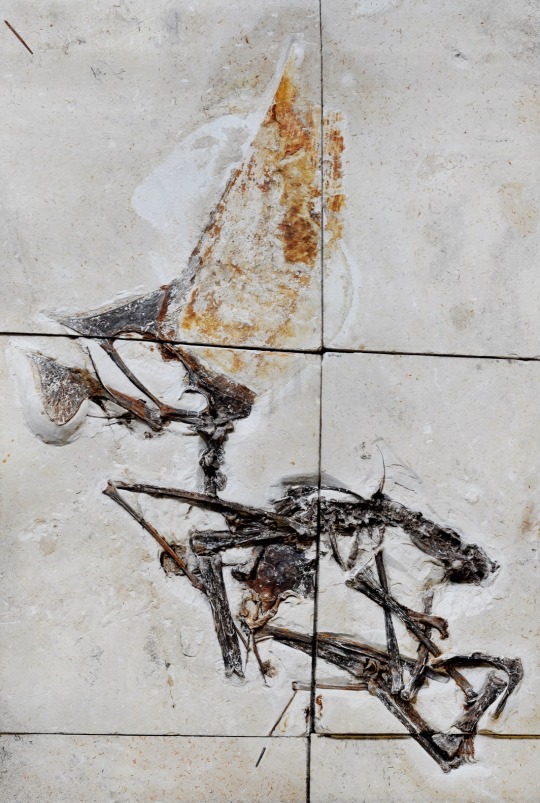

Tupandactylus/Tapejara (Art by Gabriel Ugueto): There are no big-ass bird competitors this time around, but I can offer you the next best thing: Pterosaurs! There have been many pterosaur species described from Brazilian fossil sites and they have greatly improved our understanding of these creatures. I picked Tupandactylus/Tapejara (there is some dispute about naming/species) to represent this group, because their big creasts make them some of the most visually interesting pterosaurs and with a wingspan of up to 4 m they also reach quite impressive sizes.

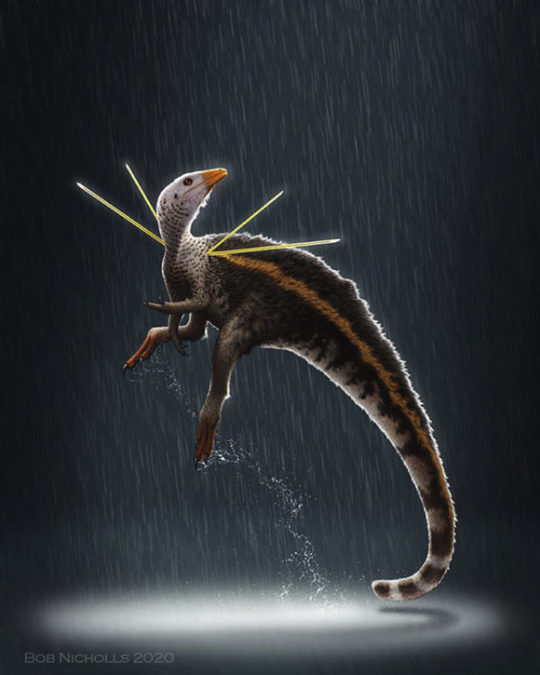
“Ubirajara“ (Art by Bob Nicholls): Next up is a small theropod dinosaur. The fossil has been found in Brazil, but then was smuggled out of the country (allegedly) and found its way to Germany. A lot of legal dispute and campaigning later, the dinosaur became a bit of a symbol against colonialism in paleontology. Just this year the fossil finally found its way back home, and probably will be re-named soon, since the original paper about it has been retracted.
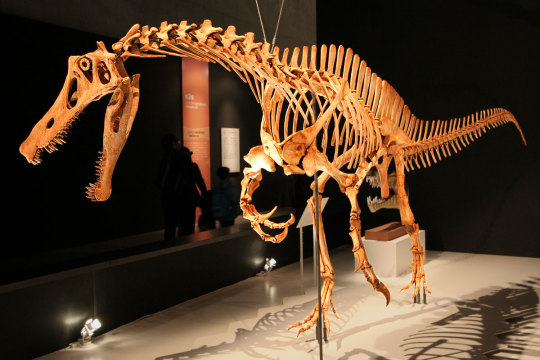
Irritator: This relative of the much more famous Spinosaurus got its name because of how frustrating and challenging the restoration of the fossil was: Fossil hunters had made a lot of changes and “repairs“ to the original skull to make it more appealing. Scientists then had to spend a lot of time undoing all those changes. But even after all of that, Irritator‘s skull is one of the best preserved spinosaur skulls ever found.


Purussaurus: This relative of modern caimans lived during the Miocene epoch. With size estimates of well over 10 m it was one of the biggest crocodylians ever, rivaling even some of the biggest carnivorous dinosaurs in terms of size.
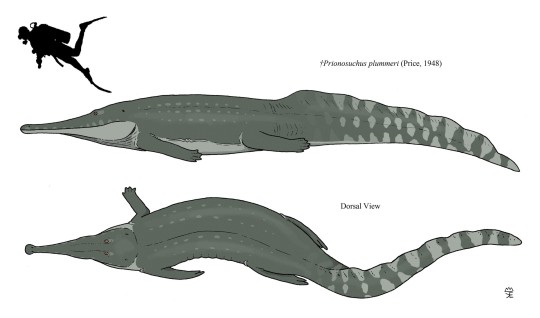
Prionosuchus (Art by Thomas Sutton): You might be wondering why I‘m showing you yet another crocodile - you are mistaken! Prionosuchus is not a croc, it is an amphibian. It lived during the Permian, so it is older than all other creatures on this list. Some of the biggest specimen found suggest that it might have reached a length of up to 9 m, making it one of the largest amphibians ever.
40 notes
·
View notes
Text
Today held an amazing surprise for me. For the second time ever, one of my illustrations (a silhouette) was featured in a published scientific paper.
Specifically, my phylopic silhouette of Toyotamaphimeia machikanensis was used in "Crocodylian princess in Taiwan: Revising the taxonomic status of Tomistoma taiwanicus from the Pleistocene of Taiwan and its paleobiogeographic implications" courtesy of Yi-Yang Cho and Cheng-Hsiu Tsai.
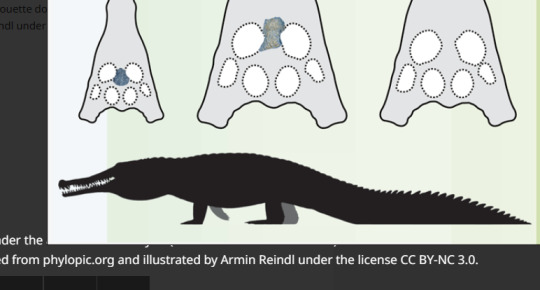
A little backstory before I briefly summ up the paper. Toyotamaphimeia machikanensis (Toyotama-hime from Mountain Machikane, after a Japanese deity that took the form of a crocodile) is a tomistomine gavialoid from the Pleistocene of Japan. A fascinating animal, being found incredibly far north for a crocodilian, 6-7 meters long and with several signs of injury from combat (including a broken off lower jaw).
Anyways, the paper itself does not deal with T. machikanensis directly. Instead, the authors take a look at various remains of tomistomines found on Taiwan, specifically Tomistoma taiwanicus and Toyotamaphimeia sp., concluding that both represent the same species they name Toyotamaphimeia taiwanicus.
While this isn't a new discovery, it's still important research, as it contributes to how we understand tomistomines and specifically removes another animal that's clearly not Tomistoma from the Tomistoma genus. (For those unaware, much like Crocodylus, Tomistoma ended up being a dumping ground for any vaguely long-snouted crocodile).
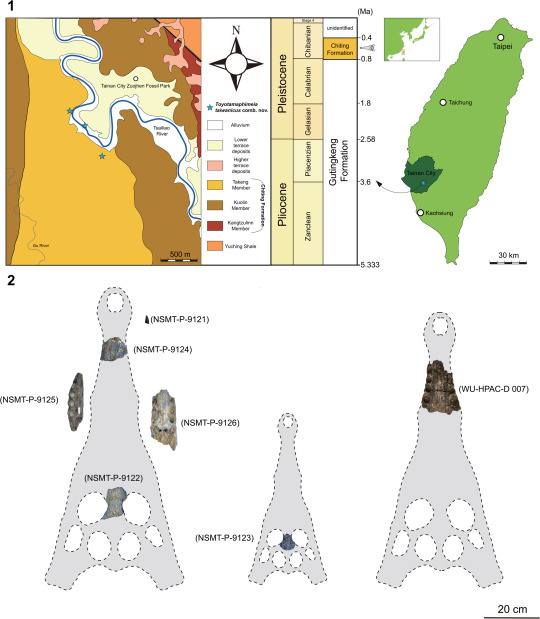
Two things are especially interesting in addition to this revision.
1) The phylogenetic analysis.
The phylogenetic analysis suggests that there was a whole group of east-asian "tomistomines" that existed from the Miocene until the Holocene. This included Penghusuchus, the oldest form from Miocene Taiwan. The tree further suggests that Penghusuchus would have eventually given rise to at least two genera. Toyotamaphimeia from Taiwan and Japan, and Hanyusuchus which lived along China's Pearl and Han Rivers (and only went extinct just 500 years ago).
The phylogeny isn't perfect, being known mostly from fragmentary fossils does mean that the group is poorly resolved, giving us a polyphyletic Toyotamaphimeia. Further one could take issue with one of the papers analysis recovering tomistomines as crocodylids, when most recent works suggest they were early gavialoids (something that is found by the authors when going purely off skull material). Regardless, such kinks notwithstanding the results do make a lot of sense and support the same broad conclusion reached by Iijima et al. 2022.

the second interesting thing is more of an untested hypothesis, but nonetheless worth pondering
2) Evolution and geography
So I mean, with Penghusuchus and T. taiwanicus both being found on Taiwan, the authors reach the quite logical conclusion that this lineage could have originated on that island, only later branching out to mainland Asia and Japan. So far so good. They further point out that, aside from a juvenile in the 2-3 meter range, material of T. taiwanicus appears to be similar in size to T. machikanensis. Which, like said before, is easily in the size range of today's biggest crocodiles and even exceeds it. This is interesting given that the Japanese species lived in relatively more colder climate. So the paper suggests that Toyotamaphimeia managed to reach gigantothermy (meaning that its great size alone already aided in stabilizing the body temperature), which then helped the animal survive more easily in colder conditions after having left Taiwan in favor of Japan. I think more study is definitely needed to confirm this, ideally with better material, but its still an interesting suggestion and potential answer to explain how Toyotamaphimeia ranged as far north as it did.

I definitely recommend checking out the paper. It's a pretty interesting and fairly quick read.
Crocodylian princess in Taiwan: Revising the taxonomic status of Tomistoma taiwanicus from the Pleistocene of Taiwan and its paleobiogeographic implications | Journal of Paleontology | Cambridge Core
#toyotamaphimeia#tomistominae#tomistoma#gavialoidea#gharial#croc#crocodile#paleontology#pleistocene#japan#palaeoblr#prehistory
60 notes
·
View notes
Text
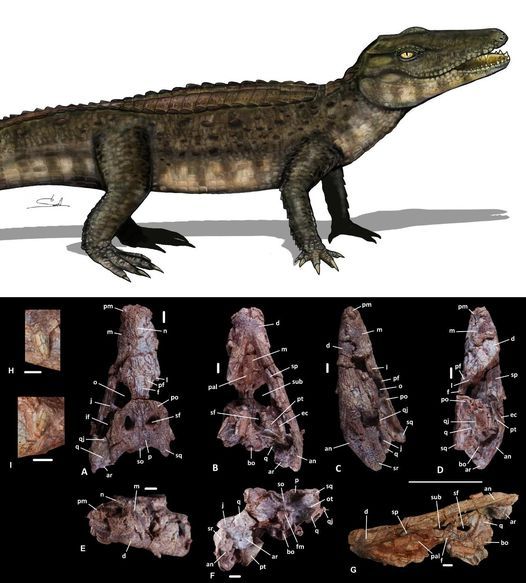
New Cretaceous neosuchians (Crocodylomorpha) from Thailand bridge the evolutionary history of atoposaurids and paralligatorids
Yohan Pochat-Cottilloux, Komsorn Lauprasert, Phornphen Chanthasit, Sita Manitkoon, Jérôme Adrien, Joël Lachambre, Romain Amiot, Jeremy E Martin
Abstract
The origin of modern crocodylians is rooted in the Cretaceous, but their evolutionary history is obscure because the relationships of outgroups and transitional forms are poorly resolved.
Here, we describe a new form, Varanosuchus sakonnakhonensis gen. nov., sp. nov., from the Early Cretaceous of Thailand that fills an evolutionary gap between Paralligatoridae and Atoposauridae, two derived neosuchian lineages with previously unsettled phylogenetic relationships.
Three individuals, including a complete skull and associated postcranial remains, allow for a detailed description and phylogenetic analysis. The new taxon is distinguished from all other crocodylomorphs by an association of features, including a narrow altirostral morphology, a dorsal part of the postorbital with an anterolaterally facing edge, a depression on the posterolateral surface of the maxilla, and fully pterygoid-bound choanae.
A phylogenetic analysis confirms the monophyly and taxonomic content of Atoposauridae and Paralligatoridae, and we underline the difficulty in reaching a robust definition of Eusuchia.
Furthermore, we put forward further arguments related to the putative terrestrial ecology with semi-aquatic affinities of atoposaurids based on their altirostral snout morphology and osteoderm ornamentation.
Read the paper here:
https://academic.oup.com/zoolinnean/advance-article-abstract/doi/10.1093/zoolinnean/zlad195/7513556
19 notes
·
View notes
Text
The Love And Care Of A Crocodile
author: pufflers
summary:
Come winter Sebek reverts back to his more crocodylian features, and who but Silver, with the help of a mysterious book, to take care of him during such a tumultuous stressful time?
Silver drives Sebek insane (more than usual.)
#twisted wonderland#silver/sebek sigvolt#silver (twisted wonderland)#sebek zigvolt#malleus draconia#lilia vanrouge#crocodile sebek#scents & smells#scenting#nesting/nest building#touching#teething#tail touching#suggestive#silver is a good mate without realising it
9 notes
·
View notes
Text
A speculative arboreal crocodylian

A year ago I began my research on the Mekosuchians, especially around the genus Mekosuchus and my already very strong skepticism at that time about the claims that they were tree-dwelling crocodiles (Something extremely improbable and which I may comment on another occasion. For now you can read in depth about Mekosuchus in this post by Armin).
At that point I wondered ; what would an arboreal crocodile really look like if it existed?
I decided that it would be a derived member of the subfamily Caimaninae, specifically belonging to the Jacarea clade (which includes all species of the genus Caiman and Melanosuchus).
The body has evolved in a convergentely with squamates such as Varanus salvator, being thinner and more elongated than that of any other crocodylian, following the same process the tail : Once the motor that propelled it underwater, is now becoming something similar to a whip that allows it to maintain balance on the branches, losing the characteristic single and double caudal crest whorls, to the point of almost disappearing.
The dorsal osteoderms are shrinking, but are still visible and play an important role in the ecology of the animal, helping it to thermoregulate.
The limbs have been considerably widened and strengthened, an adaptation very visible in the metatarsals of the hind legs, which, together with the sharp, curved claws they have developed, help the animal to cling effectively to trees.
The skull is the most distinctive part of all, as it has not only become shorter and more robust as a whole (Males have even developed an anteorbital crest similar to that of some members of the genus Crocodylus such as C. acutus or the extinct C. checchiai ; very likely some kind of sexual dimorphism), but it is developing unique characteristics such as binocular vision, zyphodont dentition and laterodorsally positioned nostrils, all of these attributes usually associated with terrestrial hunters (although there is not a necessary relationship in all cases), thus moving away from the semi-aquatic lifestyle.
Despite this, these crocodiles are still dependent on water to a certain extent, always inhabiting the forests near the rivers and being able to swim perfectly well if necessary, just like the extant iguanas and monitor lizards.
If I had to add some kind of worldbuilding that allows the existence of this animal, it would probably be located millions of years in the future : After a cataclysmic event related to climate change, South America has suffered a process of desertification in which large bodies of water have dried up, forcing the very abundant babas (Caiman crocodilus) to move into the remaining forests and jungles, adapting to a more terrestrial lifestyle. As an isolated population of these caimans chose the birds and monkeys as their preferred prey, they would gradually follow them to the treetops.
After a few more million years, the land has recovered, and large rivers and lakes are once again flooding South America, favoring the emergence of large tropical jungles again, opening a new world for these tree-dwelling caimans. Will they manage to adapt to the new climatic conditions or will they become extinct as a consequence of this and other factors such as the emergence of new species of placental predators that threaten to occupy their niche? Well, that is uncertain.
The illustration was made in gouache and watercolors during September 2022 . I scupted a small-basic figure made in clay to in order to facilitate the understanding of the lights and shadows.
Here are some pictures of the process:

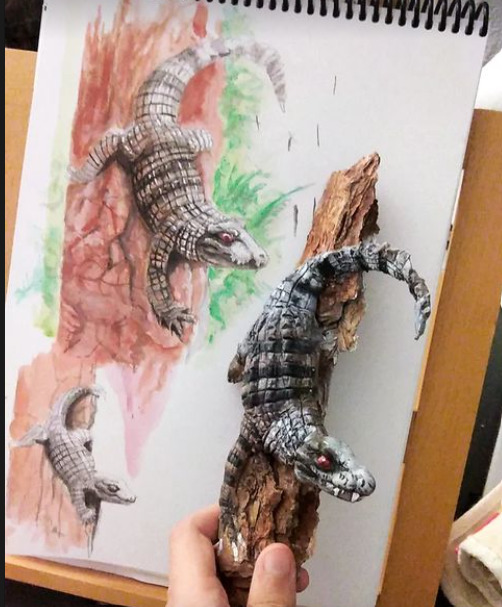
#animals#crocodiles#reptiles#zoology#crocodilians#paleoart#art#nature#speculative biology#speculative evolution#speculative zoology
230 notes
·
View notes
Text
Crocodylian princess in Taiwan: Revising the taxonomic status of Tomistoma taiwanicus from the Pleistocene of Taiwan and its paleobiogeographic implications
Re-examination the type specimens of Tomistoma taiwanicus and conducting phylogenetic analyses to explore a possible taxonomic status to Toyotamaphimeia.
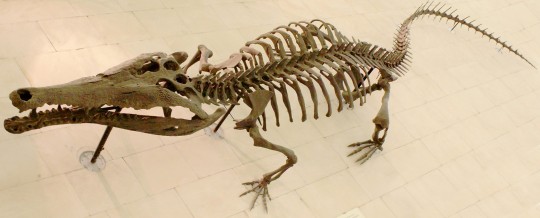
Reconstructed skeletal display of a Toyotamaphimeia from Wikipedia.
Occurrence of of Toyotamaphimeia taiwanicus and fossil material with possible positions.

NSMT-P-9122 morphological combination corresponds to that of all known Toyotamaphimeia specimens which differ from Tomistoma schlegelii by having medially curving posterolateral margin of the prefrontal and a slightly, but not prominent, upturned orbital margin. There is a difference between the Tainan material and Toyotamaphimeia machikanensis in the position of the medial maxillary occlusal pits.
The Tainan materials exhibit those pits near the anterior maxillary teeth, whereas in Toyotamaphimeia machikanensis these are positioned farther posteriorly, near the 8th–13th teeth. A reliable assignment of Tomistoma taiwanicus to Toyotamaphimeia.
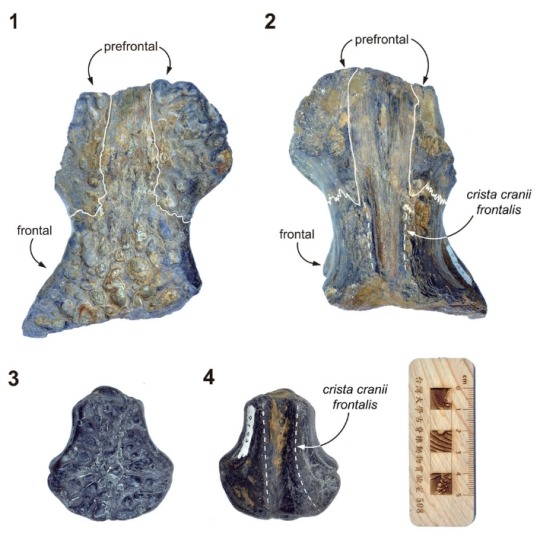
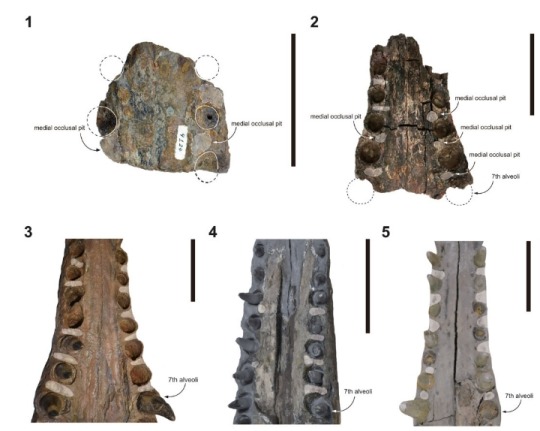
Based on the size estimation of Toyotamaphimeia machikanensis, the body size of Toyotamaphimeia taiwanicus is comparable (6m-7m long).
The sizes of given anatomical parts are almost identical to those of the holotype of Toyotamaphimeia machikanensis. The much smaller size of NSMT-P-9123 compared to NSMT-P-9122 suggests that NSMT-P-9123 belongs to a juvenile individual likely ranging from 2–3 m long.

Phylogenetic results show Toyotamaphimeia taiwanicus is in a polytomy with two clades: one formed by Hanyusuchus sinensis plus an undescribed tomistomine and one formed by the three Toyotamaphimeia specimens from Japan. The sister taxon of this polytomy is the Penghusuchus pani from Taiwan. The next more externally branching lineage includes two species of Thecachampsa. Additional skull-only analysis shows polytomy with five lineages (Toyotamaphimeia taiwanicus, NTUM-VP 200702, Hanyusuchus sinensis, Penghusuchus pani, and a clade including the three Toyotamaphimeia from Japan). This skull-only analysis generated a topology in which tomistomines are included within Gavialoidea.
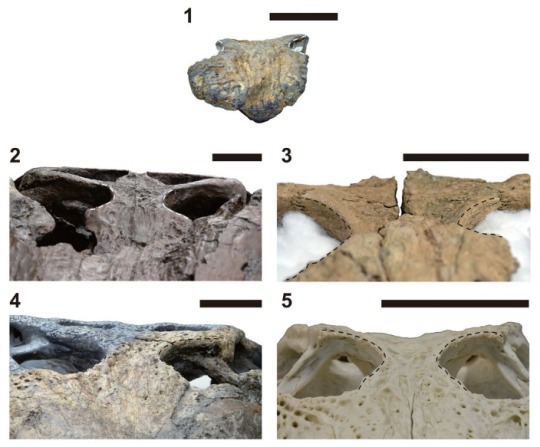
Both the all-character and skull-only analyses suggest the existence of an East Asian lineage. This morphological re-examination of the type specimens and phylogenetic analyses allow a confident reassignment of Tomistoma taiwanicus to Toyotamaphimeia taiwanicus. This suggests an East Asian, instead of Southeast Asian, influence for evolution of the Pleistocene crocodylians from Tainan, Taiwan.

Source:
Check out the scientific paper if you're interested in Toyotamaphimeia taiwanicus' re-examination, it contains a lot more information than what i shared here.
11 notes
·
View notes
Text
thinking about dinomas instead of the many other things i need to do
previous post about it:
so. more about pre eeby:

Akari the T-rex, and her three Pteranodon siblings, Dawn, Barry, and Lucas, love going on the Dinosaur train pretty much every day.
Ingo and Emmet basically run a sort of... Sociology/physiology class, where the kiddos observe different dinosaurs and try to figure out why/how they do things ("i have a hypothesis!" as Buddy says in the show)
Ingo and Emmet have friends! like Skyla the microraptor, or Elesa the Dromiceiomimus!
pretty much everyone knows about Ingo and Emmet and thier love for battles. there are specific cars on the train to house small ones, but mostly its just done near the Train station. many dinosaurs try to test their strength against the twins.
Troodons are verrry smart! so once Ingo and Emmet meet a species they've never met before, and battle them, they immediately try to figure out an effective way to take them down (again, these are all friendly battles. its enrichment, if you will)
basically Ingo and Emmet can tag team pretty much anyone. if they've met the same species before.
this is getting long so more post eeby under the cut
so, the Dino train can travel thorough time, but there are some places, if the gate is not big enough, the the train cannot go through
that, however, does not mean a dinosaur cant go through =]
so basically Ingo doesn't remember how to leave the timezone he fell in (somewhere in the Pleistocene period) and Emmet cant get there bc the time tunnels (apparently that's what they are called in the show) are too small.
pearl clan, a group of Scimitar Cat (kinda like the saber tooth/Smilodon but their teeth are Much smaller.) take Ingo in after their Lady Sneasler carries him over
no one really knows what the heck ingo is, but they let him be warden of Sneasler. both clans are actually mammals in this one, with diamond clan being Beringian lions, (who, fun fact, might have been completely maneless! which is confusing considering the cold climate, but they might have been completely covered in thick fur...)
ingo chills there for a long while, until suddenly, out of the tiny time Tunnels (or space time distortions, as the Clans call them) a T-Rex appears. the group of Tigers called the Galaxy Team take her in and they occasionally meet up with the other clans.
a few days after Akari lands in the future (ha!) a bolt hits the nobles and they go into a frenzy. Akari is sent to take care of it.
the nobles are!
Kleavor- giant beaver (cut down trees) (they were the size of bears today!)
Lilligant- Scrophulariaceae (its a flower. its kinda sentient. don't ask.)
Arcanine- Dire wolf (but a big one. for context- Dire wolves are around the same size as a yukon wolf, which is 85 cm (~2.8 ft) tall.)
Electrode- a rock. (it'd be funny)
Avalugg- the ever approaching glacial movements. (melts and gives fresh water- that's why its a noble)
and the ride pokemon just to cover all basses:
Wyrdeer- caribou
Ursaluna- giant short-faced bear (VERY big. one and a half times the size of a grizzly bear. which is. Big.)
Basculegion- Quinkana (a crocodylian! big guys!! in the time period they are in, around 6 m (20 ft) long!! there is even some debate of them being 9 m long!!)
Sneasler- giant ground sloth (up to 3 meters long!)
Braviary- Haast's eagle (one of the larges known true raptors- but with a strangle small wingspan for its size- possibly up to 3 m)
i am well aware these guys would not live in the same area btw- but im talking about a universe with dinosaurs that built a time traveling train and magic- so...
anyway, eventually Akari and Ingo meet, and both are like "i have seen you before!!" but other than that vague feeling they don't really remember. she and Ingo talk a lot, and eventually come to the realization that the space time distortions (time tunnels) could lead them home.
Ingo instinctively knows that they should Not just. walk in one, and instead they chip away the the surrounding rock of one until ingo feels its Just the right size. for what, he isn't sure. he does think that there should be some shiny metal things coming out of it... but he doesn't know where to get that kind of material, so he doesn't bother with it.
one night, they are woken up by a sheer whistle, and then a horrible crash. Ingo rushes out to the Time tunnel to see a train completely derailed in front of it, tipped over onto its side.
a white Troodon stumbles out of it.
anyway thanks for reading this far! here is some art of ingo i did =]

#no shading today#sorry#dinomas#submas au#submas#you guys have no idea how much research i did for this#it feels kinda silly but also remembering my old dino hyper fixation...#could be worse!#also- how everyone interacts is decidedly inaccurate#in that they would all live on different ends of the globe#also where they live in game is nothing like the animals actual habitat...#sloths do Not live in the mountains#but. eh.#there is. more i want to dig into and explain#but ill. do that later#ah... im so sorry my other WIPs... this has completely derailed me...#oh yeah#if anyone wonders anything about this ever#or like#wants clarification#i will answer happily#thanks for reading *this* far#i hope you have a very nice day =]#ray's art
18 notes
·
View notes
Note
What animal is your fursona?
Chompers is a dragon!
But not only that, chompers is inspired by crocodylians, crocodilomorphs, gorillas, The Marsupilami, boars, apple trees, belugas but only for the neck, the thu'um from skyrim, a bunch of characters from obscure anime that randomly got dubbed in my native language when i was a Babie....
One day ill have to make a whole Character Design Dossiêr for Chompers, cuz they just act as my dumping ground for concepts i like....
(They's been slowly getting more and more gorilla like! Look at them!)
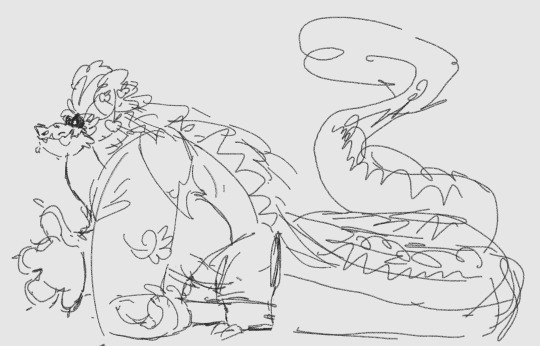
#Me making chompers have a goristance is so brave. So brave#Also i did change their stompers to be gorilike too
8 notes
·
View notes